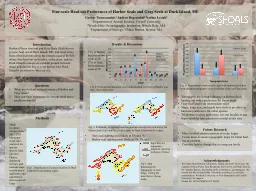

George Tsourounakis 1 Andrea Bogomolni 2 Nadine Lysiak 3 1 Department of Animal Science Cornell University 2 Woods Hole Oceanographic Institution Woods Hole MA 3 Deptartment of Biology UMass Boston Boston MA ID: 547589
Download Presentation The PPT/PDF document "Fine-scale Haul-out Preferences of Harbo..." is the property of its rightful owner. Permission is granted to download and print the materials on this web site for personal, non-commercial use only, and to display it on your personal computer provided you do not modify the materials and that you retain all copyright notices contained in the materials. By downloading content from our website, you accept the terms of this agreement.
Slide1
Fine-scale Haul-out Preferences of Harbor Seals and Gray Seals at Duck Island, ME
George Tsourounakis
1
Andrea Bogomolni
2 Nadine Lysiak31Department of Animal Science, Cornell University2Woods Hole Oceanographic Institution, Woods Hole, MA3Deptartment of Biology, UMass Boston, Boston, MA
Introduction
Harbor (
Phoca
vitulina
) and Gray Seals (Halichoerus grypus) haul out at Duck Island, ME, and most arrive from other locations along the eastern coast of the US where they haul out on beaches, rocky areas, and ice. Duck Island is unique as a middle ground between major populations but, it is not known why Duck Island is an attractive haul out site.
Results & Discussion
Questions
What are the haul-out preferences of Harbor and Gray Seals?
How can these parameters be incorporated into a predictive model?
Methods
Mark/ recapture surveys from 2012-2015Minimum count data analyzed for species- specific haul out sitesPhotos, shipboard surveys, and nautical maps used to assess qualitative and quantitative factors of each ledge
Fig 1. Identification of census location on Duck Island and surrounding ledges
33% of Harbor Seal minimum count at 2S37% of Gray Seal minimum count at 3S
Fig. 2. Proportional minimum count with standard error bars of Harbor and Gray Seals 2012-2016
Fig. 3. Probability of sighting based on presence at ledge for each survey for Harbor Seals (left) and Gray Seals (right) on Duck Island and the ledges
Gray seal sighting most likely at 3N and 3SHarbor seal sighitng most likely at 3N, 3S, and 2
Fig. 6. Proportional count at each ledge with standard error bars with assigned topography score for Harbor Seals and Gray Seals
Future ResearchMore detailed characterization of rocky ledgesCreate more accurate topographic maps for better haul-out assessmentCorrelate habitat change due to rising sea levels
AcknowledgmentsWe thank Shoals Marine Laboratory. Thank you to Dr. Jim Coyer, the captains (Ossian Foley, Tom Klodenski, Ben Carver, and Mike Rosen), Dr. Jennifer Seavey, the kitchen staff, coordinators, and managers. We would also like to thank Mila Calandrino and Meg Carr for their contributions. We thank University of New Hampshire and Cornell University for support. Permit No. NOAA NMFS LOC 20412
Fig
5
. Map illustrating the topography of each ledge, 1 being the most flat to 3 being rocky
Topography has a clear influence on Harbor Seals hauling out with a preference for flatter areasGray Seals prefer an intermediate reliefSlope, ledge size, and depth have little to no effect on haul-out preferences for either species While there is clear preference, it is not feasible to put these variables into a predictive model at this time
Fig 4. Key for topography judgment, depicting rockiness of ledges